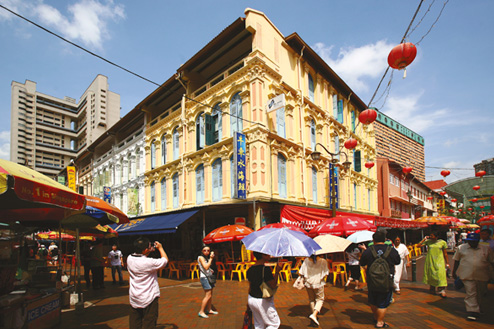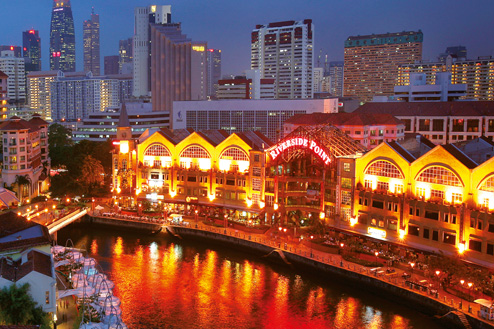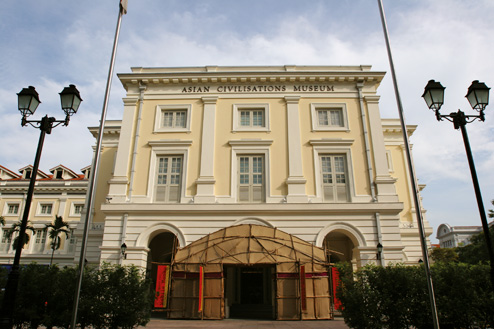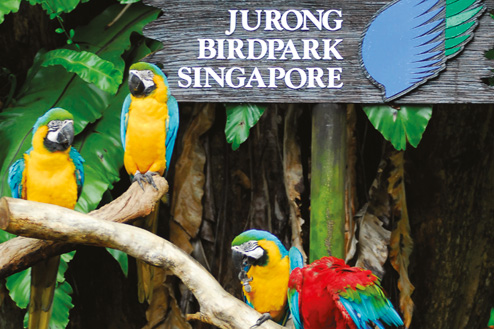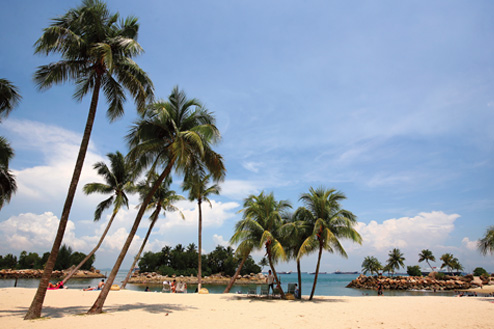Arab Street, Kampong Glam & Geylang
Kampong Glam (or Gelam) literally means ‘village of eucalyptus’. Gelam is a eucalypt variety that grew nearby and was used in oils for medicines and for making boats watertight. Previously home to Singapore’s Malay aristocracy before colonial rule, Kampong Glam and Arab Street area remain a relaxing and interesting area to eat, explore and learn about the city’s Malay roots. Under the Raffles Plan, Kampong Glam was set aside for the Sultan of Singapore and the Malay and Arab communities. This, and the number of important mosques in the district, means this area is also often referred to as the ‘Muslim Quarter’.
While much of the Malay community later moved to Geylang and other suburbs, the area is still an important one for the community. It buzzes with activity during the fasting month of Ramadan, when many Muslims break their fast here, and buy food and traditional wares for the feast that follows, Hari Raya Puasa. The area is a great place to eat and explore, tucked nicely away from much of the bustle of the central city. Stroll around its famous textile shops, and check out the stores selling fishing tackle, jewellery and rattan furniture. Later, stop by one of the cafes for tea and to smoke a shisha pipe.
Residential
Some of Singapore’s most noted mosques are in the area, including Sultan Mosque; Hajjah Fatimah Mosque on Beach Road, a mosque that was built in 1846 featuring British-influenced architecture and a minaret that leans six degrees off centre, and was named after a Malakan-born Malay woman who once lived on the site and married a wealthy Bugis sultan; and Abdul Gaffoor Mosque, finished in 1910, with a unique sundial believed to be the only one of its kind in the Islamic world – inscribed with the names of 25 chosen prophets in Arabic calligraphy. There is also Istana Kampong Glam, the palace of the former Sultan of Singapore and now the Malay Heritage Centre.
While much of the Malay community later moved to Geylang and other suburbs, the area is still an important one for the community. It buzzes with activity during the fasting month of Ramadan, when many Muslims break their fast here, and buy food and traditional wares for the feast that follows, Hari Raya Puasa. The area is a great place to eat and explore, tucked nicely away from much of the bustle of the central city. Stroll around its famous textile shops, and check out the stores selling fishing tackle, jewellery and rattan furniture. Later, stop by one of the cafes for tea and to smoke a shisha pipe.
Residential
Expatriates seeking cheap residential accommodation will have to put up with the area being slightly frenetic at night, but the sense of living in Asia is greater than you’ll get in a shiny new condominium.
Retail
The Geylang Serai Wet Market is a traditional Asian market crammed with stalls selling meat, fish, food and fabrics. During Ramadan, this area is the place to be in the evenings, with seasonal market stalls. Sadly though, the original market will soon be torn down to be replaced by a new multi-million dollar market complex. The retail streets of neighbouring Katong are interesting for their strong Peranakan architectural influence. The Peranakan are the indigenous Straits Chinese who lived in Singapore before the various waves of migration, and their mixed heritage is embraced as a symbol of modern Singapore. There are Peranakan-style terraces along Koon Seng Road and restaurants sell delicious Peranakan food – arguably the first example of fusion food in Singapore. The culturally rich Joo Chiat area includes daytime businesses, night restaurants and music lounges and Katong Antique House – a good place to buy authentic Peranakan artifacts.
Places of interest
Apart from its red-light district to one side, Geylang is charming, if slightly scruffy, and a great place for a late supper. Eating outdoors near the roadside is closer to a ‘real’ Asian experience than dining in many of Singapore’s shining modern areas, and the food is typically excellent. Organised into lorongs or lanes, word has it that ladies of the night (strictly-speaking, not all are ladies) operate only in alternating lorongs – those without closed circuit TV cameras.
Some of Singapore’s most noted mosques are in the area, including Sultan Mosque; Hajjah Fatimah Mosque on Beach Road, a mosque that was built in 1846 featuring British-influenced architecture and a minaret that leans six degrees off centre, and was named after a Malakan-born Malay woman who once lived on the site and married a wealthy Bugis sultan; and Abdul Gaffoor Mosque, finished in 1910, with a unique sundial believed to be the only one of its kind in the Islamic world – inscribed with the names of 25 chosen prophets in Arabic calligraphy. There is also Istana Kampong Glam, the palace of the former Sultan of Singapore and now the Malay Heritage Centre.

